by Mary Howard
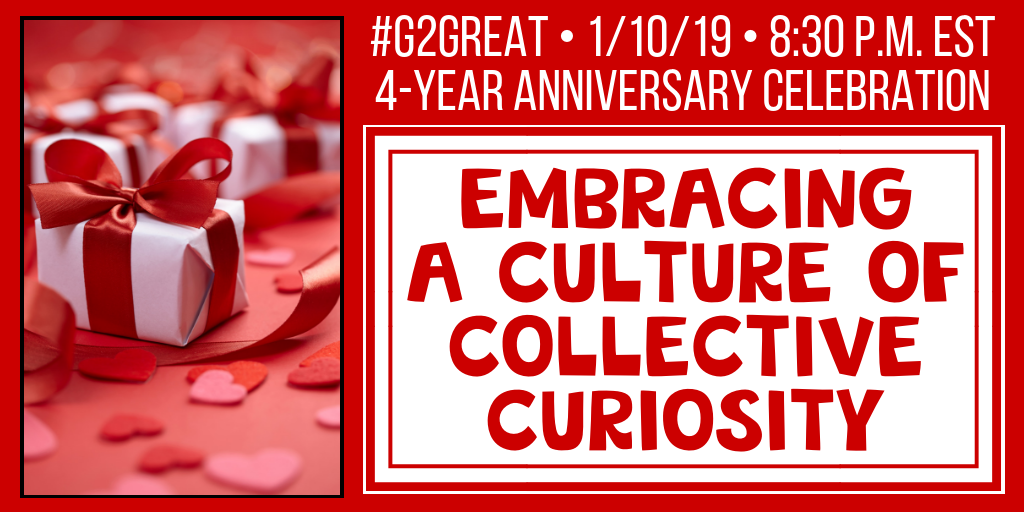
Each year when I am afforded the pleasure of announcing a new #G2Great Anniversary celebration, my heart fills with pride. When our chat door officially opened to welcome conversational dialogue Twitter style on January 8, 2015, there was no possible way that we could imagine the tremendous impact #G2great would have on so many people. We (me and co-moderators, Fran McVeigh, Jenn Hayhurst and Amy Brennan) never envisioned that a six-week exploration of my book, Good to Great Teaching, would launch a four year professional journey that grows stronger with each new year.
On our third anniversary chat on January 4, 2018, we decided to start a new tradition by celebrating a topic near and dear to our hearts: Embracing a Culture of Collective Curiosity. We saw this as an appropriate ritual since curiosity reflects the heart and soul of the #G2Great spirit. Each Thursday night at 8:30, we transform a Twitter hashtag into a community of curious collaborators. We share. We question. We dialogue. We wonder. We explore. We imagine. We envision. We dream. And through this process, we are able to awaken curiosity wonderings that gently nudge us to collective joy surrounded by curious others.
Last year in support of collective curiosity, we invited ten #G2Great educators to pose their own curiosity-inspired questions that would drive our three-year anniversary chat and then respond to those questions on this blog. We enjoyed their questions and reflections so much that we were thrilled when they all agreed to repeat this process on this four-year anniversary. And so for the second year, Brent Gilson, Kitty Donohoe, Jill Davidson and Kim Stewart, Johnny Downey, Susan Vincent, Roman Nowak, Cameron Carter, Susie Thompson Rolander, and Kara Pranikoff each generated our chat questions and responded to them for this blog post:
We celebrate their thoughtful questions and the thinking that those questions inspired in their responses below. Each slide introduces the question they posed followed by their response:
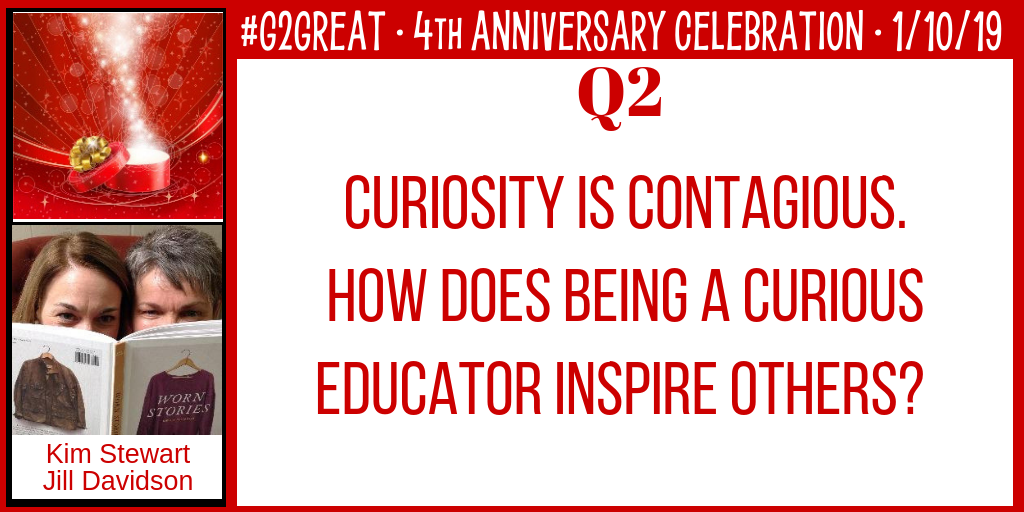
Curious educators wonder. They are playful and ask questions to make sense of the world. It is their excitement about learning and the learning of their students which can lead to innovations in education. It is this excitement that inspires other educators to explore their curiosities about learning and teaching. The collective energy of curious educators creates learning environments that stirs the minds of students!
My wish for 2019 is that we celebrate learning environments where educators and students share the joy and excitement of curious minds.
Curiosity is the desire to learn or know more. Approaching our work as educators with a disposition of curiosity means taking an inquiry stance—posing and being guided by questions about our students, our teaching, and ourselves. Curiosity is contagious and when we make our curiosities known to others, we invite them to join us in conversations about learning and teaching. These connections between curious educators, which can happen locally or virtually thanks to platforms such as Twitter, establish authentic learning communities.
In Creating Cultures of Thinking, Ron Ritchart reminds us that “for classrooms to be cultures of thinking for students, schools must be cultures of thinking for teachers.” My hope for 2019 is for educators to continue findings ways to connect with one another and share their professional curiosities in order to learn and grow together.
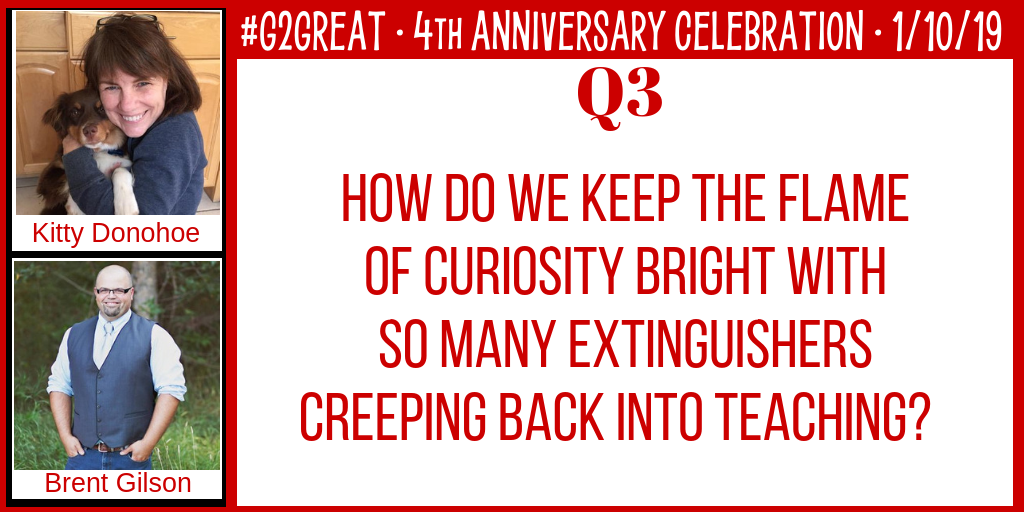
We can learn from our students. Like William Blake intones, young people “see a world in a grain of sand.” In these young minds, curiosity burns fiercely and as educators, it is our job to fan the proverbial flame and not blow it out. Finding like-minded educators will also create support for curiosity.
My wish for 2019: May all educators maintain memories of their own childhood curiosity so as to better understand their students.
Build a bigger fire. The products that claim the easy solution to difficult things teachers face can’t do anything if we don’t give them permission. Build up our students by giving them work that is worthy of them. Give them books that make them question. Give them inquiry projects and problems to solve to fuel their fire instead of oxygen-depleting garbage like AR or TPT handouts that smother a flame and destroy the sense of wonder that our students deserve.
My wish for 2019; If I had one wish for teachers it would be that they be brave enough to stand up for their student curiosity over their own convenience.
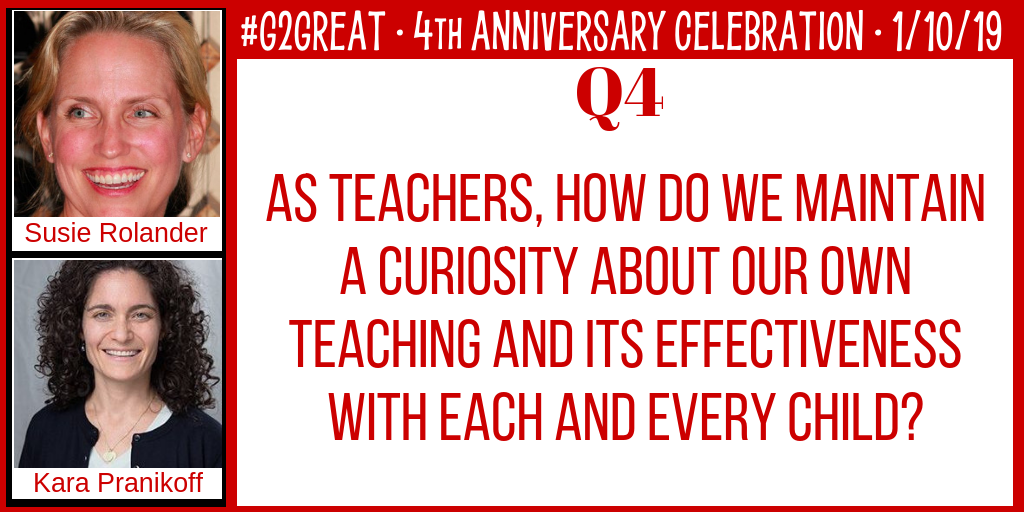
During a time where many schools are requiring teachers to use scripted programs, we MUST question the effectiveness for each and every student. We must remain curious about how we can modify our teaching. Frequent formative assessment with each of our students must drive our instruction. In fact, our curiosity needs to heighten when we are asked to use a scripted program.
My wish for 2019 is for schools to stop pushing programs and to start pushing reading books, but I know that won’t happen quickly….So my wish for 2019 is for teachers to be guided by individual student progress not by a script in a program.
Curiosity is generated by our desire to learn. That desire to learn propels and deepens our teaching. We are never experts in our craft. We are always growing and shifting and refining and trying something new. Teaching is a dynamic art. Additionally, every new student we connect with provides a new lens to consider our instruction. It’s our task to reach each individual we come in contact with, so we better remain curious. There is no one right way, this keeps us on our toes and learning, alongside our students.
My wish for 2019 is that inquiry based teaching gets a resurgence. That we go back to the roots of what we know and old constructivism at the core of what we do. We need to create environments of wonder and possibility in our classrooms so that our students can take charge of their learning and let their curiosity guide them.

Wonder and curiosity are sparked through questioning. When reading, I engage my students with questions such as “What is one thing you still wonder about ____?” or “If ___ were to change, what would happen to ____?” Effective questioning promoting wonder and curiosity allows all students to be able to answer with a sense of advocating their own voice!
My wish for 2019 is for educators to take a step back and reflect on themselves. There is no question that our profession can be tiresome. My wish is for colleagues to always take care of themselves in order to be the best they can be in the classroom! If we don’t take care of ourselves, it truly affects our students. This is my 2019 wish for all of you!
In a high school setting, where students often come to us saying they do not enjoy reading or ask if we must read more, I try to select texts that will speak to their heart and make them question their own thinking. An emotional bond with characters is important in building empathy. A desire to want to know more about a certain topic, time period or culture is a sign that I did my job; that I planted a seed of curiosity within them to want to go deeper on their own. That is our mission in literacy education.
My wish for 2019: That each student who enters the doors of high school can share a book that had a lasting impact on their lives, that they enjoyed, and that a natural curiosity and willingness to read is shared by them.
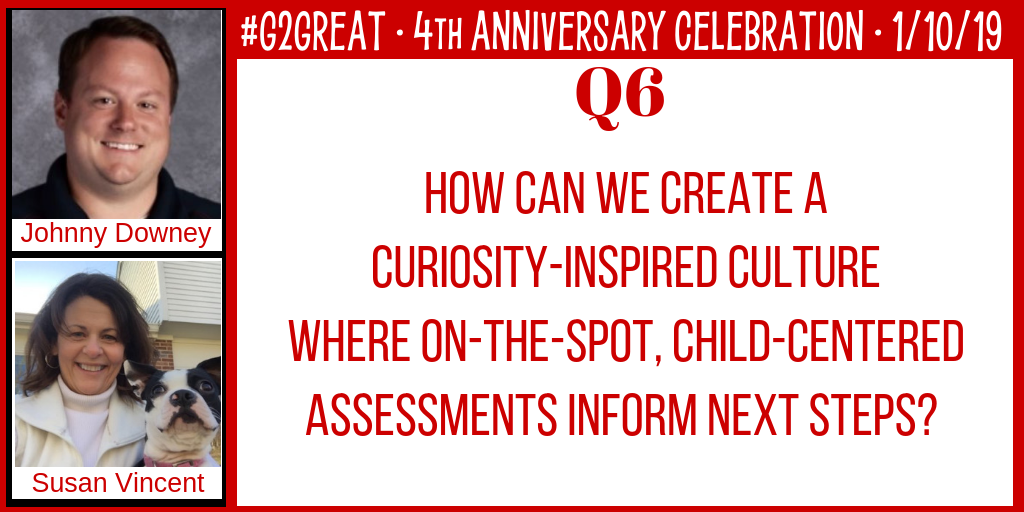
In Reading Recovery we learn about the importance of observational assessments. Marie Clay always talked about needing nothing more than a blank piece of paper. If teachers would remain curious about the way their students are learning, thinking, and growing, we could keep the essence of Marie Clay’s curiosity alive. There is nothing better than sitting next to a child with a fresh piece of paper, and a fresh outlook on the lesson. Standardized tests, screeners, and surface level assessments have a place in raising a flag, or allowing for a quick temperature check. If teachers were to only check a temperature and never diagnose for problems then students everywhere would be lost. There is a recent obsession with quick tests to find quick information but this is not and never will be enough information to actually teach children. Remaining a curious teacher, and using good observational diagnostic assessment data, will lead to more children obtaining what they need.
We need to be curious enough about our students to want to dig deeper than standardized tests can dig. Observation as assessment allows us to make responsive teaching decisions. Our Reading Recovery colleagues used a football coach analogy— coaches don’t plan practices just based on game scores. They watch game footage and then plan practices based on observation of what happens during the game. We could learn from this.
Johnny and Susan Wish for 2019: We hope teachers remain curious about their students and use child-centered assessments to better serve their needs.
Mary’s Final Reflections
When we asked our #G2great friends to participate in our Anniversary Chat again this year, they didn’t hesitate. Their eagerness to breathe life into our anniversary chat once again and then respond in writing for this blog post reflects their deep commitment to this topic of curiosity – a commitment that is shared by every educator who attended our chat this week and many of the weeks before this.
We are so grateful to those of you who return to our chat week after week to engage in collegial dialogue that supports and extends your curiosities as we merge them with those of others. Each of you epitomize curiosity and all it means to our teaching and ultimately to the students who inspire us to make curiosity our priority, both for ourselves and for our students. #G2Great was born within a spirit of curiosity that inspires us to reach far higher than scripts, boxes, programs or packages. We want more than these narrow “DOINGS” that do little to fuel the curiosity that will in turn fuel curiosity for students.
Curiosity begins as a burning ember residing within us all but is is our choice whether we will nurture those embers until it ignites into a celebratory exploration that invites a sense of joyful professional collaborations. This has defined #G2Great for the past four years and it will continue to be our driving force on your behalf.
And so, our wish for you is that your 2019 is filled to brimming with both individually and collectively inspired curiosities. #G2Great is a true labor of love for us, but it would be little more than that if it were not for your dedicated commitment to this profession and to our children. We are so grateful to each of you and we look forward to learning and growing in your company in the years ahead!
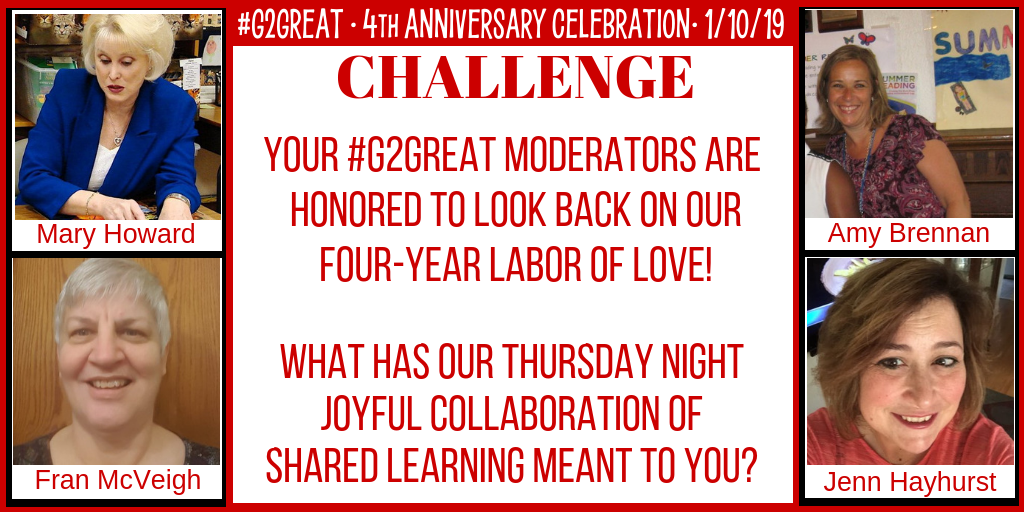
We hope you’ll reflect on this challenge and add #G2Great